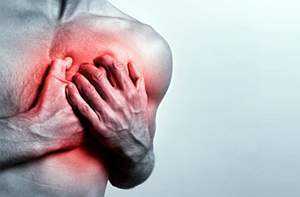 Intercostal neurosis - compression of the intercostal nerves caused by trauma, compression injuries, inflammations, which is accompanied by acute burning or shooting pain in the ribs. The disease is observed in people of different ages, but most often in adults.
Intercostal neurosis - compression of the intercostal nerves caused by trauma, compression injuries, inflammations, which is accompanied by acute burning or shooting pain in the ribs. The disease is observed in people of different ages, but most often in adults.
There are sensitive, motor and sympathetic fibers in the structure of intercostal nerves. Intercostal nerves form 12 pairs. They provide innervation of the chest, mammary glands, pleura( rib-diaphragmatic), anterior abdominal wall, peritoneum.
Sensitive fibers of neighboring nerves are connected, and thus there is a cross innervation( one area of the skin or muscle is innervated by the main nerve, as well as neighboring ones).
Contents
- Damage mechanism and its causes
- Clinical picture and the correct diagnosis
- Provision of medical care
- Anti-inflammatory therapy
- Etiotropic treatment
- Physiotherapy methods
- Prevention of disease
Mechanism of damage and its causes
Intercostal neurosis( neuralgia) occurs due to infringement) of nerves in the intercostal space, or as a result of pinching the spine of the spinal nerve. Roots are entangled due to the manifestations of osteochondrosis, and also because of Bekhterev's disease, spondylitis.
Intercostal muscles infringe the nerve as a result of the muscle spasm or inflammation present, and thus cause nerve irritation. Muscle spasm can be caused by psychological stress, traumatic effects, excessive physical exertion.

Inflammation and spasm of the intercostal muscles can also occur due to transferred infections, hypothermia, lung diseases.
The reasons for the development of intercostal neurosis also include:
- poisoning;
- changes in the spine caused by hormonal changes during the menopause;
- polyradiculoneuritis;
- multiple sclerosis;
- allergic diseases;
- osteochondrosis, arthrosis, curvature of the spine, chest deformation, intervertebral hernia, thoracic spondylosis;
- aortic aneurysm, benign pleural tumor, neoplasm of the thoracic wall( chondrosarcoma, lipoma, rhabdomyoma, chondroma, osteoma);
- herpetic infection;
- diseases of internal organs;
- microtrauma with regular physical stress;
- diabetes mellitus;
- trauma of the chest, fracture of the ribs, spinal injury;
- excessive drinking;
- sharp movements;
- lack of B vitamins;
- metabolic disorders in neural tissues;
- incorrect position during operation.
Clinical picture and statement of the correct diagnosis
Intercostal neurosis has characteristic symptoms that distinguish it from cardiac pain, with which it is often confused: 
- permanent or periodic pain in the costal region( dull or acute);
- redness, blanching of the skin, muscle twitching, increased sweating;
- intensification of pain during coughing, sneezing, sudden changes in body position;
- pain in the scapula and waist;
- pain during palpation of certain points of the thoracic spine;
- numbness of tissues at the site of nerve fiber damage.
Symptoms of intercostal neuralgia are similar to those of cardiac, pulmonary pathologies, stomach diseases. An accurate diagnosis should be made by a doctor, since only a specialist can distinguish pain from these diseases.
The pains in the heart pathologies are moderate, have a contracting character, and pass after taking coronary dilatations. At movements, change of position of a body, inconvenient positions such pain does not become stronger.
Pains with a neurosis are permanent, become more intense during movements, touching, improper position of the body, sneezing, coughing. Taking painkillers and other medications does not relieve pain.
Neuralgia of the lower intercostal nerves for pain may be similar to diseases of the stomach( peptic ulcer, gastritis), pancreatic diseases, namely pancreatitis.
In stomach diseases, a painful attack is less strong and longer, and is often caused by eating. Pancreatitis is characterized by girdling pains on both sides, which also occur after eating.
To differentiate the disease, the gastrointestinal tract is examined: gastroscopy, determination of pancreatic enzymes in the blood.
 Intercostal neurosis may occur as a symptom of thoracic radiculitis. In this case, painful attacks are combined with constant blunt pain in the back area, which decrease after taking a horizontal position. The condition of the spine is examined by chest radiography. In case of suspicion of a herniated intervertebral disc, a magnetic resonance tomography of the spine is performed.
Intercostal neurosis may occur as a symptom of thoracic radiculitis. In this case, painful attacks are combined with constant blunt pain in the back area, which decrease after taking a horizontal position. The condition of the spine is examined by chest radiography. In case of suspicion of a herniated intervertebral disc, a magnetic resonance tomography of the spine is performed.
Intercostal neuralgia also occurs as a symptom in lung diseases( lung cancer, pleurisy, SARS).When suspected of these diseases, an overview radiograph of the chest, CT scan.
Medical care
In the treatment of intercostal neurosis, complex therapy is used, which aims to eliminate symptomatic pain, restore the nerve, and treat a primary disease that provoked neuralgia. Treatment can be both conservative and surgical. Surgical methods include decompression neuroplasty and radiofrequency denervation.
Let's consider the basic directions at treatment of disease.
Anti-inflammatory therapy
In inflammatory processes in the nerve endings are assigned Nimesulide, Diclofenac, Nurofen, Piroxicam. Pain syndrome can  be removed with the help of injections, blockades( anesthetics and glucocorticosteroids).
be removed with the help of injections, blockades( anesthetics and glucocorticosteroids).
When muscle spasm is used muscle relaxants( Balkofen, Sirdalud, Midokalm).To reduce the intensity of pain, sedatives are also prescribed. Atypical pain in the chest area is applied radio-frequency destruction of the stellate node.
Neuropathic pains are stopped by radio-frequency neuromodulation of the spinal roots. The use of B vitamins will strengthen the nervous system.
Etiotropic treatment
The direction of therapy depends on the underlying cause of neuralgia:
- herpes zoster - antiviral drugs( Gerpevir, Acyclovir, Famciclovir), antihistamines, antiherpetic ointments;
- muscular-tonic syndrome - muscle relaxants( Midokalm, Tizanidine);
- osteochondrosis, displacement of vertebrae - dry spinal traction, manual therapy( to relieve compression of the intercostal nerve);
- pathology of the spine, myelopathy, radiculopathy - injection of steroids into the epidural space;
- tumors - surgical methods of treatment.
Physiotherapy methods
Physiotherapy procedures are used for arthropathy, spondyloarthrosis, infringements:
- magnetotherapy;

- Novocaine electrophoresis;
- amplipulse;
- thermal procedures;
- UHF-therapy;
- ultraphonophoresis;
- reflexotherapy.
The methods of oriental medicine are also often used: moxotherapy, acupuncture, acupressure, hot stones, hirudotherapy.
Neurotropic treatment is also used:
- injection of group B vitamins In
- injection of ascorbic acid;
Prevention of Disease
Intercostal neurosis can be prevented by treating emerging problems, spine diseases and preventing its  curvature, timely treatment of injuries in the chest area.
curvature, timely treatment of injuries in the chest area.
Avoiding herpes infection, which provokes neuralgia, will help to increase the level of immunity.
This can be achieved through sport, adequate physical exertion, hardening, healthy lifestyle.
As a preventive measure, also reduce the amount of stress, reduce alcohol consumption, and normalize the level of physical activity.



